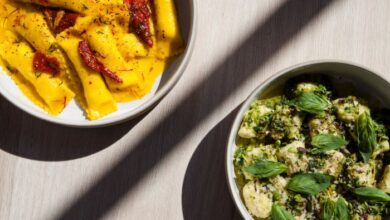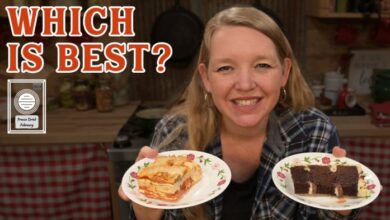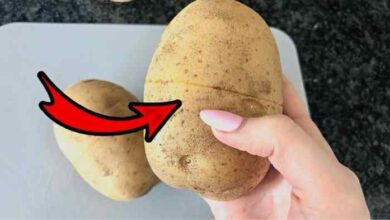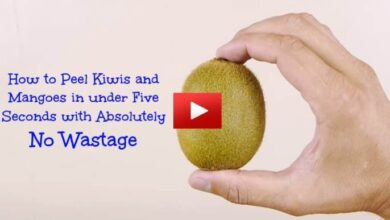
Fastest Way to Get the Yolk Out: A Guide to Perfect Separation
Fastest way to get the yolk out? We’ve all been there, staring at an egg, wondering how to separate the yolk from the white without ending up with a scrambled mess. This simple task can feel like a culinary puzzle, but fear not! There are tried-and-true methods, along with some innovative techniques, that make separating yolks a breeze.
Whether you’re a seasoned chef or a baking novice, mastering this skill will unlock a world of possibilities in the kitchen.
This guide explores the most common and efficient yolk separation methods, delving into their pros and cons. We’ll examine the science behind these techniques, revealing the secrets to achieving a perfect separation every time. From classic methods to modern tools, you’ll discover the strategies that best suit your needs and preferences.
The Importance of Separating the Yolk
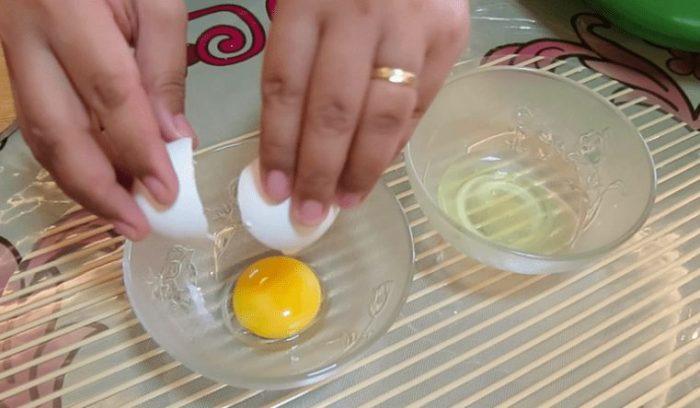
Separating egg yolks from whites is a fundamental skill in cooking and baking. This technique is essential for achieving specific textures and flavors in various dishes. Understanding the reasons behind yolk separation can elevate your culinary skills and lead to more successful outcomes.
The Role of Yolks and Whites in Baking
Egg yolks and whites play distinct roles in baking, each contributing to different aspects of the final product. Egg yolks are rich in fat and contribute to the richness, color, and emulsification properties of baked goods. Egg whites, on the other hand, are primarily protein and are responsible for providing structure and volume.
Separating the yolks from the whites allows for precise control over these individual properties, resulting in more predictable and consistent results.
Examples of Recipes Where Yolk Separation is Crucial
- Angel Food Cake:The airy texture of angel food cake relies solely on the whipped egg whites for structure. Separating the yolks ensures that no fat is introduced into the whites, allowing them to whip into a stable, voluminous foam.
- Meringues:Meringues, like angel food cake, are entirely dependent on the whipping power of egg whites. Separating the yolks eliminates any fat that could inhibit the whites from whipping properly, resulting in a light and airy meringue.
- Hollandaise Sauce:Hollandaise sauce is an emulsion of egg yolks, butter, and lemon juice. The yolks provide the emulsifying agent that binds the butter and lemon juice together. Separating the yolks ensures a smooth and velvety sauce, free from any interference from the egg whites.
Common Yolk Separation Methods
Separating egg yolks from whites is a fundamental skill in baking and cooking. Whether you’re making delicate meringues, light and fluffy soufflés, or creamy sauces, the quality of your yolk separation directly impacts the final outcome. Mastering these techniques ensures you achieve the desired texture and consistency for your culinary creations.
Common Yolk Separation Methods
| Method Name | Description | Advantages | Disadvantages |
|---|---|---|---|
| Shell Method | Crack the egg into a bowl and gently transfer the yolk between the halves of the cracked shell. Let the white drip into a separate bowl. | Simple and quick. Requires minimal equipment. | Can be messy. Requires practice to avoid breaking the yolk. |
| Spoon Method | Crack the egg into a bowl and use a spoon to carefully scoop the yolk, leaving the white behind. | Easy to learn. Suitable for beginners. | May not be as precise as other methods. Can result in some white mixing with the yolk. |
| Egg Separator | This device features two bowls: one for the yolk and one for the white. Crack the egg into the separator, and the yolk will be caught in the lower bowl while the white flows into the upper bowl. | Fast and efficient. Minimizes mess and potential for yolk breakage. | Requires a dedicated tool. May not be suitable for large quantities of eggs. |
The “Fastest” Method Debate
When it comes to separating egg yolks, speed is often a key factor, especially in busy kitchens. But the quest for the fastest method isn’t just about saving time; it’s also about minimizing mess and maximizing efficiency. The “fastest” method, however, depends on various factors, including the individual’s skill level and the freshness of the eggs.
Comparing Separation Methods
The speed of different yolk separation methods is influenced by factors like the individual’s dexterity, the size of the yolk, and the consistency of the egg white.
- The Shell Method:This method involves cracking the egg and carefully transferring the yolk between the halves of the shell. It’s generally considered a fast method, especially for experienced cooks, as it allows for quick and precise yolk separation. However, it can be messy if the egg white spills, and it might not be suitable for beginners.
- The Spoon Method:This technique involves using a spoon to scoop out the yolk, leaving the white behind. It’s often considered a more beginner-friendly option, but it can be slower and more prone to breaking the yolk.
- The Egg Separator Tool:This tool features a small, funnel-like opening with a spring-loaded plunger. The yolk is placed in the funnel, and the plunger pushes the white through the opening, leaving the yolk behind. While this method is often advertised as the fastest, its effectiveness can depend on the tool’s quality and the user’s technique.
Factors Influencing Speed
The speed of yolk separation can also be influenced by the freshness of the eggs and the individual’s skill level.
- Egg Freshness:Fresh eggs tend to have thicker whites, which can make separation more challenging and potentially slower. Older eggs have thinner whites, making them easier to separate, and potentially leading to faster separation times.
- Skill Level:Experienced cooks often develop faster and more efficient techniques for separating yolks. They can anticipate the movement of the yolk and manipulate the egg with more precision, leading to faster separation times.
Techniques for Perfect Yolk Separation
Now that we’ve established the “fastest” method for separating yolks, let’s delve into the techniques that ensure a clean and successful separation every time.
The Bottle Technique: A Step-by-Step Guide
The bottle technique is widely considered the quickest and most efficient method. Here’s a step-by-step guide to master it:
- Crack the Egg:Gently crack the egg on a flat surface, ensuring the shell is not broken into multiple pieces.
- Position the Egg:Hold the egg over the bottle’s opening, allowing the white to drip into the bottle.
- Squeeze Gently:Apply gentle pressure to the egg, allowing the white to flow freely.
The fastest way to get the yolk out of an egg is to carefully crack it open and let the white run out, leaving the yolk behind. But before you go buying a whole bunch of vinyl records, check out this great vinyl post finally what you need to know before you buy vinyl – it’ll help you make sure you’re getting the right stuff for your setup.
Once you’ve got your vinyl sorted, you can get back to perfecting your yolk-separating technique!
- Tilt the Bottle:Tilt the bottle slightly to help guide the white into the bottle.
- Separate the Yolk:Once the white is fully separated, carefully lift the yolk from the bottle’s opening.
Visual Guide: Bottle Technique
Imagine a clear glass bottle with a wide opening. The egg is held above the bottle, its cracked shell allowing the white to drip into the bottle.
As the white flows, the yolk remains intact, perched on the opening. The bottle is then tilted slightly to encourage the remaining white to drain, leaving a pristine yolk ready to be lifted.
Essential Tips and Tricks
- Choose the Right Bottle:Opt for a bottle with a wide opening and a narrow neck. This prevents the yolk from falling into the bottle while allowing for easy separation.
- Crack Carefully:Cracking the egg gently ensures a clean break and avoids shattering the shell.
- Practice Patience:The bottle technique requires a steady hand and a bit of practice. Don’t rush the process, and allow the white to flow naturally.
- Clean Up:Once you’ve separated the yolk, rinse the bottle and dry it for future use.
Avoiding Yolk Contamination
Maintaining the integrity of the yolk during separation is crucial for various culinary applications. Even a small amount of white mixed into the yolk can alter its texture and flavor, impacting the final dish.
Potential Causes of Yolk Contamination, Fastest way to get the yolk out
Several factors can contribute to the accidental mixing of yolk and white during separation. Understanding these causes helps in implementing preventative measures.
- Cracked Yolk:If the yolk breaks during the separation process, the white will inevitably mix in.
- Rough Handling:Excessive force or rough handling can cause the yolk to break.
- Improper Tools:Using the wrong tools or those that are not clean can lead to contamination.
- Temperature:Cold eggs are more likely to crack and break, increasing the risk of contamination.
- Moisture:Excess moisture on the hands or tools can dilute the yolk and make it more fragile.
Preventative Measures for Clean Separation
By implementing the following measures, you can significantly minimize the risk of yolk contamination and ensure a clean separation.
Sometimes, the fastest way to get the yolk out of an egg is to just crack it open and let it slide out! It’s not always the most elegant method, but it gets the job done. And if you’re looking for a fun and festive way to enjoy a sweet treat, check out this 3 2 1 blast off with patriotic popsicles 2 recipe.
You can even use the leftover egg whites to make a delicious meringue for topping your popsicles! So whether you’re in the kitchen or enjoying a summer barbecue, there’s always a fun way to make things a little more interesting.
- Gentle Handling:Handle eggs with care to avoid cracking the yolk.
- Clean Tools:Ensure your hands and tools are clean and dry before separating the eggs.
- Room Temperature Eggs:Allow eggs to reach room temperature before separating, as they are less likely to crack.
- Proper Technique:Utilize a gentle technique that minimizes pressure on the yolk, such as the “spoon and bowl” method or the “shell-half” method.
- Avoid Over-Mixing:Do not over-mix the white, as this can create a whirlpool effect that can draw the yolk into the white.
Impact of Contamination on the Final Dish
The impact of yolk contamination on the final dish can vary depending on the recipe. For example, in recipes like mayonnaise, even a small amount of white can lead to instability and separation. In desserts, contamination can affect the texture and appearance.
“Even a small amount of white mixed into the yolk can alter its texture and flavor, impacting the final dish.”
Yolk Separation Tools and Equipment

Beyond the classic methods of separating yolks, specialized tools can make the process faster, cleaner, and more efficient. These tools are particularly useful for bakers, chefs, and anyone who frequently works with eggs.
Types of Yolk Separation Tools
A variety of tools are available to assist in separating egg yolks from whites. Each tool offers distinct features and benefits, catering to different needs and preferences.
- Egg Separator: This classic tool features a small, round bowl with a perforated bottom. The egg is cracked over the bowl, allowing the white to drain through the holes while the yolk remains in the bowl.
- Egg Separator with Suction: Similar to the standard egg separator, this tool incorporates a suction mechanism. This allows the yolk to be easily lifted from the bowl, leaving the white behind.
- Egg Separator with Funnel: This tool combines a funnel with a strainer. The egg is cracked into the funnel, and the white is drained through the strainer, leaving the yolk in the funnel.
- Egg Separator with a Squeeze Bottle: This tool consists of a squeeze bottle with a small opening. The egg is cracked into the bottle, and the white is squeezed out through the opening, leaving the yolk behind.
- Egg Separator with a Whisk: This tool features a whisk with a small opening at the bottom. The egg is cracked into the whisk, and the white is whisked through the opening, leaving the yolk behind.
- Egg Separator with a Spoon: This method involves using a spoon to carefully scoop the yolk out of the cracked egg. The spoon’s shape helps to gently lift the yolk without breaking it.
Comparison of Yolk Separation Tools
The effectiveness and ease of use of each tool can vary, depending on the individual’s preferences and skill level. The following table provides a comparison of different yolk separation tools based on their features, effectiveness, ease of use, and cost.
| Tool | Features | Effectiveness | Ease of Use | Cost |
|---|---|---|---|---|
| Egg Separator | Simple design, perforated bottom | Effective for most egg yolks | Easy to use | Low |
| Egg Separator with Suction | Suction mechanism, easy yolk removal | Very effective, minimal yolk breakage | Easy to use | Moderate |
| Egg Separator with Funnel | Funnel and strainer, efficient separation | Effective for large quantities of eggs | Moderate | Moderate |
| Egg Separator with a Squeeze Bottle | Squeeze bottle with small opening | Effective, minimal mess | Moderate | Low |
| Egg Separator with a Whisk | Whisk with opening, efficient separation | Effective for small quantities of eggs | Easy to use | Low |
| Egg Separator with a Spoon | Spoon for scooping yolks | Effective for delicate yolks | Requires some skill | Low |
Alternatives to Traditional Separation: Fastest Way To Get The Yolk Out
While the traditional methods of separating egg yolks are effective, there are alternative techniques that can be just as efficient and even more convenient, especially for specific culinary applications. These unconventional methods often leverage physical properties of the egg components and offer unique advantages for certain recipes.
Separating Yolks Using a Straw
This method relies on the suction created by a straw to draw the yolk into a separate container.
- Crack the egg into a bowl.
- Carefully position the straw over the yolk and gently suck up the yolk.
- Transfer the yolk to a separate container.
This technique is particularly useful for recipes that require a small amount of yolk, like making mayonnaise or hollandaise sauce.
Separating Yolks Using a Funnel
Funnels can be used to separate egg yolks by strategically positioning the funnel over the yolk.
- Crack the egg into a bowl.
- Place a funnel over the yolk, ensuring the opening of the funnel is wider than the yolk.
- Gently tilt the bowl, allowing the white to flow through the funnel, leaving the yolk behind.
This method works best with larger funnels and is helpful when separating multiple yolks simultaneously.
Separating Yolks Using a Plastic Bottle
This technique involves using a plastic bottle to create a vacuum that draws the yolk into the bottle.
- Crack the egg into a bowl.
- Cut the bottom off a plastic bottle and place the bottle opening over the yolk.
- Gently squeeze the bottle, creating a vacuum that draws the yolk into the bottle.
This method is quick and efficient, but requires careful handling to avoid breaking the yolk.
Separating Yolks Using a Spoon
This method utilizes the natural buoyancy of the yolk to separate it from the white.
- Crack the egg into a bowl.
- Carefully slide a spoon under the yolk, lifting it gently from the bowl.
- Transfer the yolk to a separate container.
This technique is effective for separating individual yolks, but may not be suitable for larger quantities.
Separating Yolks Using a Sieve
Sieves can be used to separate yolks by allowing the white to pass through the sieve while retaining the yolk.
- Crack the egg into a bowl.
- Place a sieve over the bowl and gently pour the egg mixture through the sieve.
- The white will pass through the sieve, leaving the yolk behind.
This method is useful for separating multiple yolks simultaneously and is especially effective for recipes that require a clean separation of the yolk and white.
Separating Yolks Using a Handheld Egg Separator
These tools are specifically designed to separate egg yolks and whites.
- Crack the egg into the separator.
- The separator will automatically separate the yolk from the white, allowing you to collect each component separately.
This method is quick and convenient, but requires the use of a dedicated tool.

